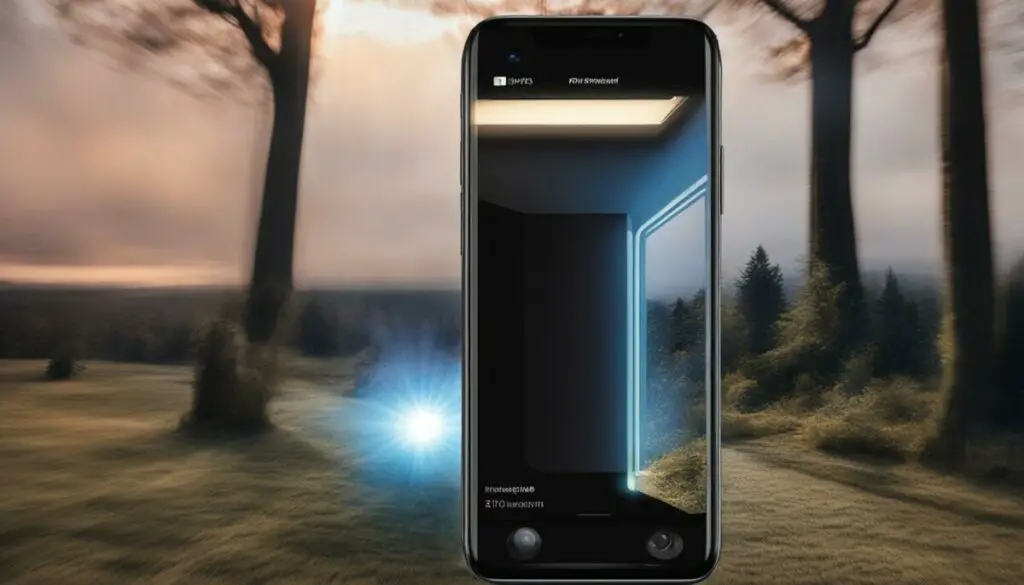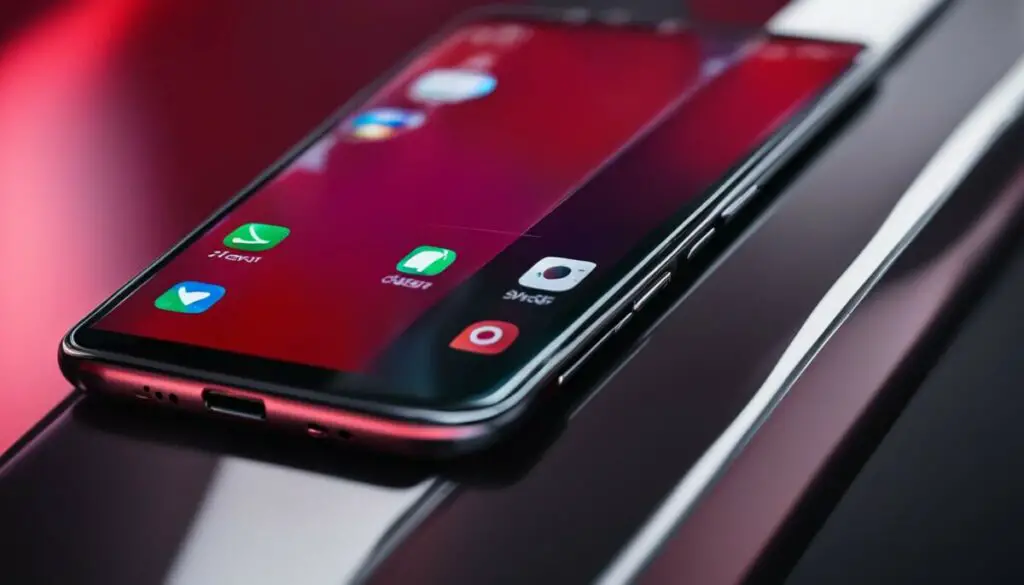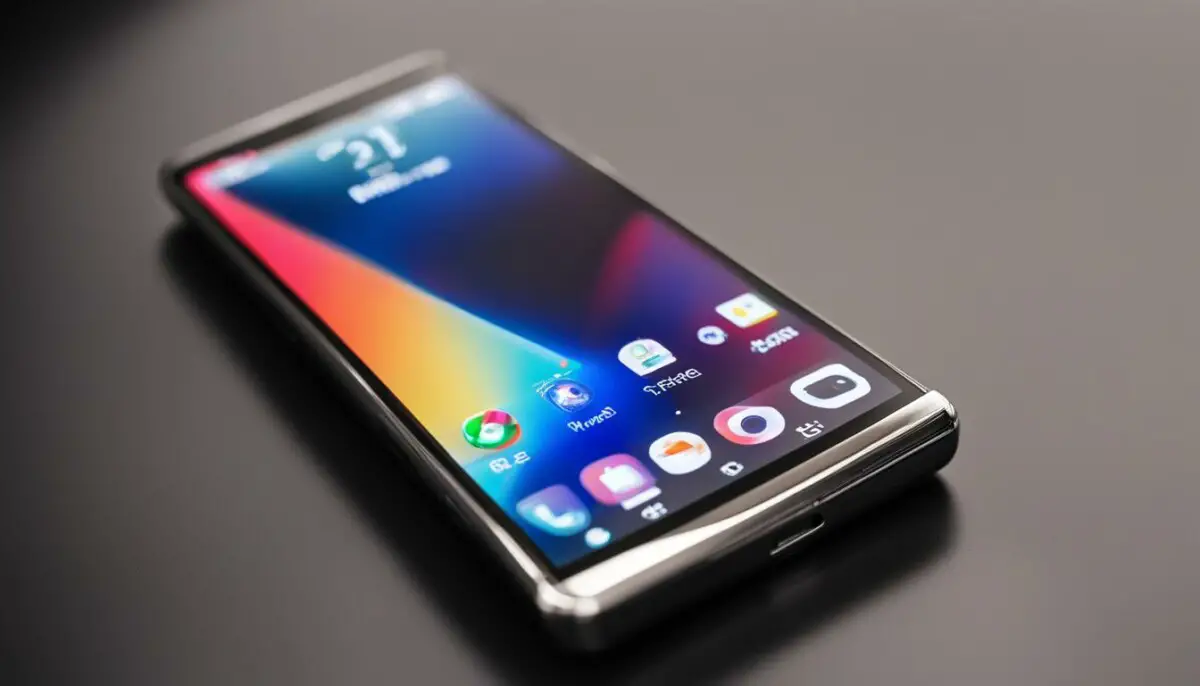Last Updated on 5 months by Francis
Welcome to our informative article about infrared ports on phones! If you’ve ever wondered what an infrared port is and how it functions on your phone, you’ve come to the right place. In this section, we’ll define what an infrared port is and provide you with an overview of its functionality. Let’s dive in!
An infrared port is a specialized port found on electronic devices, including phones, that utilizes infrared light to send and receive information. In the past, it was commonly used for wireless communication but has since been largely replaced by radio frequency (RF) technology. Infrared ports can still be found on older systems and devices like television remotes. However, they do come with a few limitations, such as a line of sight restriction and a relatively short range.
Contents
Key Takeaways:
- An infrared port on a phone uses infrared light for wireless communication.
- It has been largely replaced by RF technology but can still be found on older devices.
- Line of sight is required for infrared communication.
- Infrared ports have a shorter range compared to other wireless technologies.
The Functionality of Infrared Port on a Phone

An infrared port on a phone enables wireless communication through infrared rays. It works within a range of about 10 meters. With an infrared port, users can interact with their phone and control devices that are compatible with infrared technology, such as televisions and air conditioning units.
The benefits of an infrared port include the ability to control devices remotely and the convenience of not needing a physical cable connection. Users can simply point their phone’s infrared port towards the device they want to control and transmit commands wirelessly. This eliminates the need for multiple remote controls, as the phone can serve as a universal remote for various devices.
In addition to device control, the infrared port on a phone can also be used for file transfer between compatible devices. This is particularly useful for older mobile devices that used infrared for wireless file transfer. Users can easily transfer photos, videos, and other files between their phone and other devices without the need for cables or internet connectivity.
Benefits of Infrared Port on a Phone:
- Wireless device control: Users can control devices like televisions and air conditioning units from their phone.
- Universal remote functionality: The phone can serve as a universal remote, eliminating the need for multiple remotes.
- Convenient file transfer: Users can transfer files wirelessly between their phone and other compatible devices.
- No need for physical cables: The infrared port eliminates the need for physical cable connections.
| Device Control | File Transfer |
|---|---|
| Users can control devices like televisions and air conditioning units from their phone. | Users can transfer files wirelessly between their phone and other compatible devices. |
| The phone serves as a universal remote, eliminating the need for multiple remotes. | This is particularly useful for older devices that used infrared for wireless file transfer. |
Infrared Port vs Bluetooth on a Phone
Infrared port and Bluetooth are both wireless communication technologies used on mobile devices. However, they have some key differences. Infrared communication uses infrared rays to transmit data and requires line of sight between devices. Bluetooth, on the other hand, uses radio waves and does not require direct line of sight. Bluetooth also has a longer range compared to an infrared port. Both technologies have their own advantages and are used for different purposes on mobile devices.
When comparing the two, one of the main differences is the range. Infrared ports typically have a range of about 10 meters, while Bluetooth can reach distances of up to 100 meters or more, depending on the class of the Bluetooth device. This makes Bluetooth more suitable for situations where devices are not in close proximity to each other.
Another difference is the line of sight requirement. Infrared communication requires a clear line of sight between the devices in order to function properly. This means that obstacles such as walls or other objects can hinder the communication. Bluetooth, on the other hand, does not require direct line of sight and can transmit data even if there are obstacles between the devices.
Both technologies have their own advantages and are used in different scenarios. Infrared ports are commonly used for device control, such as controlling televisions or air conditioning units. Bluetooth, on the other hand, is used for a wide range of applications, including wireless audio streaming, file transfer, and connecting peripheral devices such as keyboards and speakers.
| Infrared Port | Bluetooth |
|---|---|
| Requires line of sight | No line of sight required |
| Range of about 10 meters | Range of up to 100 meters or more |
| Mainly used for device control | Used for various applications including audio streaming and file transfer |
How to Identify and Use the Infrared Port on a Phone

To identify if a phone has an infrared port, users can look for a small bubble or transparent material covering a port on the device’s top edge. This port may also light up when in operation. Once identified, users can make the most of the infrared port on their phone by downloading specific apps designed for their phone’s brand. For example, Xiaomi users can download the “My Remote” app, while Huawei users can opt for the “Smart Controller” app. These apps allow users to control compatible devices using the infrared port on their phones.
Not only can users control televisions and air conditioning units, but they can also use the infrared port on their phone for other purposes. One such purpose is to recover files from older mobile devices that used infrared for wireless file transfer. Additionally, the infrared port can be used to control audio equipment like stereo systems and even learn features on old devices that may no longer have functioning remote controls. The versatility of the infrared port on a phone ensures that users can interact with a wide range of devices.
Some apps even offer the ability to learn commands from existing infrared remotes, making it easier for users to control their devices seamlessly. With the infrared port on a phone, users can enjoy the convenience of wireless control without the need for physical cable connections. It is important to note that while some phones may come with built-in infrared ports, others may require the use of an external dongle that plugs into the phone’s charging port to provide the necessary infrared transmission capability.
| Pros | Cons |
|---|---|
| Provides wireless communication | Line of sight restriction |
| Ability to control devices remotely | Short range |
| No need for physical cable connection | |
| Versatile usage |
Other Uses of the Infrared Port on a Phone
Aside from controlling devices like televisions and air conditioners, the infrared port on a phone has various other useful applications.
One notable use of the infrared port is for file recovery. In the past, many mobile devices used infrared for wireless file transfer. If you have files stored on an older device that utilized infrared technology, you can use the infrared port on your phone to recover those files. This can be particularly handy if you have important documents, photos, or videos that you want to transfer to your new phone.
Additionally, the infrared port on a phone can be used to control audio equipment such as stereo systems. By downloading compatible apps, users can transform their phone into a universal remote and control their audio devices seamlessly. This feature is especially convenient if you have multiple audio systems in different rooms and don’t want to constantly switch between remotes.
An interesting application of the infrared port is its ability to learn features on old devices that may no longer have functioning remote controls. By using a learning app, you can easily teach your phone’s infrared port the commands from your old remote control, allowing you to continue using and enjoying your older devices.
| Uses of Infrared Port on a Phone |
|---|
| Controlling devices like televisions and air conditioners |
| Recovering files from older mobile devices |
| Controlling audio equipment such as stereo systems |
| Learning features on old devices without functioning remotes |
Installing an Infrared Port on a Phone
While many modern smartphones no longer have built-in infrared ports, it is still possible to install one on your phone if you require this functionality. One method of doing so is by using a dongle that plugs into your phone’s charging port. The dongle provides the necessary infrared transmission capability, allowing you to control compatible devices using infrared technology.
However, it is important to note that not all phones may be compatible with external infrared port installations. Before attempting to install an infrared port on your phone, it is recommended to consult with the phone manufacturer or a mobile device specialist. They can provide guidance on whether your phone supports external infrared port installations and recommend any specific dongle or accessory that may be required.
Installing an infrared port on a phone can open up a range of possibilities, allowing you to control various devices and expand the functionality of your smartphone. Whether you want to use your phone as a universal remote or interact with older devices that rely on infrared technology, installing an infrared port can provide convenience and flexibility.
Benefits of Installing an Infrared Port on a Phone
There are several benefits to installing an infrared port on your phone. Firstly, it allows you to control devices using infrared technology, such as televisions, air conditioners, and audio equipment, right from your smartphone. This eliminates the need for multiple remote controls and simplifies the control of your home entertainment system.
Additionally, installing an infrared port on your phone can enable you to interact with older devices that may not have wireless connectivity options other than infrared. This can be particularly useful for recovering files from older mobile devices or learning features on vintage electronics that no longer have functioning remote controls.
Overall, while the prevalence of RF technology has diminished the use of infrared ports on phones, installing an infrared port can still provide value and expand the capabilities of your smartphone. It is worth considering if you have a specific need for infrared functionality or if you want to enhance your device’s versatility.
Advancements in Infrared Port Technology
The use of infrared ports may have diminished with the rise of RF technology, but that hasn’t stopped advancements in infrared port technology. These advancements have focused on improving the range and transmission speeds of infrared communication, making it more powerful and efficient. The advancements in infrared port technology have enabled faster and more reliable data transfer, enhancing the overall user experience.
One key area of development in infrared port technology is the expansion of its range. While the traditional range of an infrared port is limited to about 10 meters, newer technologies have pushed this boundary further. Some infrared port devices now boast ranges of up to 100 meters, allowing for communication over longer distances.
Another notable improvement in infrared port technology is the increased transmission speeds. Older infrared ports had slower data transfer rates, which limited their effectiveness in certain applications. However, newer infrared port technologies have achieved higher transmission speeds, enabling quicker data transfer between devices. This improvement is particularly beneficial when transferring large files or streaming media.
| Infrared Port Advancements | Benefits |
|---|---|
| Extended range | Allows for communication over longer distances. |
| Higher transmission speeds | Enables quicker data transfer between devices. |
| Enhanced compatibility | Improves interoperability with a wider range of devices. |
Furthermore, advancements in infrared port technology have also focused on enhancing compatibility with a wider range of devices. Infrared ports are now designed to be more versatile and can communicate with various types of devices, including smartphones, tablets, and smart home appliances. This improved compatibility allows for seamless integration and control between different devices in a home or office environment.
In conclusion, while RF technology may be more prevalent in wireless communication, advancements in infrared port technology have continued to provide alternative connectivity options. These advancements have resulted in improved range, faster data transfer speeds, and enhanced compatibility with various devices. While the future of infrared port technology remains uncertain, it continues to evolve and meet specialized needs, offering users more options for wireless connectivity.
Infrared Port on Phones vs Other Types of Ports
An infrared port is just one type of port found on electronic devices, each with its own characteristics and uses. Let’s take a look at how the infrared port on phones compares to other types of ports in terms of functionality and connectivity.
Infrared Port
The infrared port on a phone utilizes infrared light for wireless communication. It has a limited range of around 10 meters and requires a direct line of sight between devices. The infrared port is commonly used for controlling compatible devices, such as televisions and air conditioning units, through the phone. It also allows for wireless file transfer and interaction with audio equipment.
Other Types of Ports
Other types of ports found on electronic devices include serial ports, parallel ports, PS/2 ports, USB ports, VGA ports, and more. These ports serve different purposes and have varying capabilities. For example, USB ports are commonly used for data transfer and device charging, while VGA ports are used for connecting monitors or projectors to display devices. Each port type has its own set of characteristics and functionalities.
Here is a table summarizing the characteristics of computer ports:
| Port Type | Functionality | Connection Type | Common Uses |
|---|---|---|---|
| Serial Port | Serial data transfer | Physical connector | Connecting legacy devices |
| Parallel Port | Parallel data transfer | Physical connector | Connecting printers and other parallel devices |
| PS/2 Port | Connecting keyboards and mice | Physical connector | Connecting keyboards and mice |
| USB Port | Data transfer and device charging | Physical connector | Connecting external storage devices, peripherals, and charging smartphones |
| VGA Port | Video output | Physical connector | Connecting monitors and projectors |
As technology continues to evolve, the functionalities and uses of different ports may change. It is important to consider the specific requirements of your devices and their compatibility with different port types when connecting and transferring data.
The Future of Infrared Port Technology
As technology continues to advance, the future of infrared port technology remains an intriguing topic. While radio frequency (RF) technology has become the standard for wireless communication, there may still be potential for infrared ports in niche applications. The unique characteristics of infrared communication, such as its line of sight requirement and short range, could offer advantages in specific industries or use cases.
Advancements in infrared port technology have already improved its range and transmission speeds. These developments pave the way for faster and more reliable data transfer, making infrared communication a viable option for certain scenarios. Additionally, the ability to control various devices remotely using an infrared port could be particularly beneficial in home automation systems and other smart technologies.
However, the widespread adoption of RF technology poses a challenge for the future of infrared ports. The convenience and versatility of Bluetooth and Wi-Fi have made them the go-to options for wireless connectivity. Manufacturers are prioritizing these technologies in their devices, which may limit the integration and availability of infrared ports.
Nonetheless, it is important to recognize that technology trends are ever-evolving. There may still be untapped potential for infrared port technology in the future, especially as new applications and demands arise. Continued research and development could lead to innovations that enhance the capabilities and compatibility of infrared ports, making them a valuable addition to the wireless communication landscape.
| Advantages of Infrared Port Technology | Challenges for Infrared Port Technology |
|---|---|
|
|
Conclusion
In conclusion, an infrared port on a phone is a valuable feature that enables wireless communication through infrared rays. Although it has been largely replaced by RF technology, the infrared port still offers unique functionalities and benefits, such as device control and compatibility with older devices. Despite uncertainties about its future, infrared port technology continues to provide versatility and options for wireless connectivity on mobile devices.
The infrared port allows users to interact with their phones and control various devices, such as televisions and air conditioning units, without the need for a physical cable connection. It offers the convenience of remote control and the ability to learn commands from existing infrared remotes. Additionally, the infrared port can be used to recover files from older devices and control audio equipment like stereo systems.
While RF technology dominates wireless communication, there may still be niche applications where infrared communication is preferred or necessary. Advancements in infrared technology may lead to greater adoption and integration in certain industries or for specific use cases. The future potential of infrared port technology will be determined by further research and development in the field. Overall, the infrared port remains a valuable tool for wireless connectivity, providing users with flexibility and compatibility.
FAQ
What is an infrared port on a phone?
An infrared port on a phone is a feature that enables wireless communication through infrared rays. It allows users to control compatible devices and interact with their phone without the need for physical cable connections.
How does an infrared port on a phone work?
An infrared port on a phone uses infrared rays to transmit and receive data. It requires line of sight between devices and has a range of approximately 10 meters.
What are the benefits of an infrared port on a phone?
The benefits of an infrared port on a phone include the ability to control devices remotely and the convenience of not needing a physical cable connection. Users can interact with their phone and control compatible devices such as televisions and air conditioning units.
How does an infrared port on a phone compare to Bluetooth?
Infrared communication on a phone uses infrared rays and requires line of sight between devices, while Bluetooth uses radio waves and does not require direct line of sight. Bluetooth also has a longer range compared to an infrared port.
How can I identify if my phone has an infrared port?
Look for a small bubble or transparent material covering a port on the top edge of your phone. This port may also light up when in operation. Additionally, you can consult your phone’s user manual or contact the manufacturer for confirmation.
How can I use the infrared port on my phone?
To use the infrared port, you can download specific apps for your phone’s brand. These apps allow you to control compatible devices using the infrared port. Some apps even offer the ability to learn commands from existing infrared remotes.
What are the other uses of the infrared port on a phone?
In addition to controlling devices like televisions and air conditioners, the infrared port on a phone can be used to recover files from older devices, control audio equipment, and learn features on old devices that may no longer have functioning remote controls.
Can I install an infrared port on my phone?
It is possible to install an infrared port on a phone through the use of a dongle that plugs into the phone’s charging port. However, not all phones may be compatible with external infrared port installations. It is recommended to consult with the phone manufacturer or a mobile device specialist for guidance on installing an infrared port.
What advancements have been made in infrared port technology?
Advancements in infrared port technology have focused on improving the range and transmission speeds of infrared communication. Newer infrared port technologies are more powerful and efficient, enabling faster and more reliable data transfer.
How does the infrared port on a phone compare to other types of ports?
The infrared port on a phone is unique in that it utilizes infrared light for wireless communication. Other types of ports, such as serial ports, parallel ports, USB ports, and VGA ports, serve different purposes and have their own characteristics and uses.
What is the future of infrared port technology on phones?
While RF technology dominates wireless communication, the future of infrared port technology remains uncertain. However, there may still be niche applications where infrared communication is preferred or necessary. Further research and development will determine the future potential of infrared port technology.









